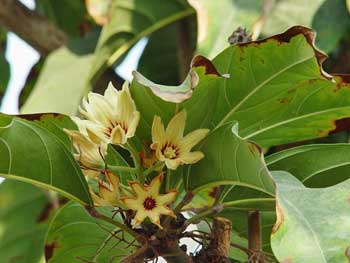Contents:
Common Names | Parts Usually Used | Plant(s) & Culture | Where Found | Medicinal Properties | Biochemical Information
Legends, Myths and Stories | Uses | Formulas or Dosages | Bibliography
Scientific Names

- Cola acuminata L.
- Sterculia family
Common Names
- Caffeine nut
- Kola nut
- Guru nut
Parts Usually Used
Seed
Back to Top
Description of Plant(s) and
Culture
The fruit of the kola tree is a yellowish-brown woody pod that contains several large, flattened, white or red nut.
Back to Top
Where Found
Grows wild in West Africa and is cultivated in tropical South America and in the West Indies.
Back to Top
Medicinal Properties
Stimulant, tonic
Back to Top
Biochemical Information
1.1% to 2.5% caffeine and kolanin
Back to Top
Legends, Myths and Stories
The kola or cola nut has been used for ages in Africa as a masticatory; often combined with grains of paradise. The nuts were used to make a stimulating native beverage. Natives sometimes endured hardships or dangers in order to obtain a supply of kola nuts. The nuts contain 1.1% to 2.5% caffeine and kolanin. The stimulating effect of the nuts, when chewed, is more slowly produced and longer lasting because the caffeine-kolanin constituents are combined with about 50% nutritive matter. Kola nuts, in the fresh state, are bitter at first but this is soon followed by an agreeable sweetish taste.. Nuts are much used in “soft” drinks and in liqueurs and wines.
Exported kola nuts, as we receive them, become extremely hard and are not used as a masticatory.
Back to Top
Uses
Kola nuts contain more caffeine than coffee berries and are taken as a stimulant to prevent fatigue. They also act as a tonic agent for the heart and are sometimes useful in relieving pains of neuralgia and headache.
Back to Top
Formulas or Dosages
Infusion: steep 1 tsp. kola nuts in 1 cup water. Take 1 cup per day.
Powder: the powder can be taken conveniently in size 00 gelatin capsules, 1 or 2 at a time as needed.
Back to Top
Bibliography
![]() The Herb Book
The Herb Book, by John Lust, Bantam Books, 666 Fifth Avenue, New York, NY. copyright 1974.
 Old Ways Rediscovered
Old Ways Rediscovered, by Clarence Meyer, Meyerbooks, publisher, PO Box 427, Glenwood, Illinois 60425, published from 1954, print 1988
![]() Webster’s New World Dictionary
Webster’s New World Dictionary, Third College Edition, Victoria Neufeldt, Editor in Chief, New World Dictionaries: A Division of Simon & Schuster, Inc., 15 Columbus Circle, New York, NY 10023
